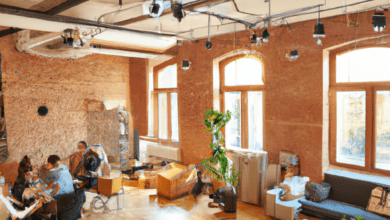Redefining Urban Life: The Impact of Co-Living and Co-Working Spaces on Community and Collaboration

In recent years, the landscape of urban life has undergone a profound transformation, driven by shifting demographics, evolving work patterns, and an increasing desire for community connection. As cities become more densely populated and the traditional notions of living and working continue to blur, co-living and co-working spaces have emerged as innovative solutions to the challenges of modern urban existence. These shared environments not only offer practical benefits such as affordability and flexibility but also foster a sense of belonging and collaboration among residents and professionals alike. In this article, we will explore the evolution of urban living through the lens of co-living spaces that are redefining community dynamics, delve into the powerful synergy between co-working and co-living environments that allows individuals to work, live, and thrive in harmony, and examine the broader economic and social impacts of these shared spaces in an increasingly urbanized world. Join us as we navigate this exciting shift in urban lifestyle, where collaboration and community are at the forefront of innovation and growth.
- 1. **"The Evolution of Urban Living: How Co-Living Spaces Are Redefining Community"**
- 2. **"Work, Live, Thrive: The Synergy of Co-Working and Co-Living Environments"**
- 3. **"Urbanization and Collaboration: The Economic and Social Impacts of Shared Spaces"**
1. **"The Evolution of Urban Living: How Co-Living Spaces Are Redefining Community"**
In recent years, the urban landscape has witnessed a significant transformation, driven largely by the rise of co-living spaces that are redefining the very notion of community. Traditionally, urban living was characterized by individualism and a degree of isolation, with people often residing in separate apartments or homes that limited interaction with neighbors. However, the increasing cost of living, particularly in major metropolitan areas, has prompted a shift towards shared living arrangements that foster connection and collaboration.
Co-living spaces offer more than just affordable housing; they promote a lifestyle centered around communal living, where residents share not only physical space but also experiences and resources. These environments are designed to encourage social interaction, with shared kitchens, lounges, and recreational areas that serve as hubs for residents to gather, collaborate, and build relationships. This shift towards shared living arrangements reflects a growing desire for community and belonging, particularly among younger generations who prioritize experiences over material possessions.
Moreover, co-living spaces often attract like-minded individuals, creating a sense of camaraderie and shared purpose. Many of these developments cater to specific demographics, such as young professionals, creatives, or digital nomads, fostering a vibrant community culture unique to each space. This intentional design encourages networking, collaboration, and support among residents, transforming the way people interact within urban settings.
The evolution of urban living through co-living is also a response to broader societal changes, including the rise of remote work and the gig economy. As more individuals embrace flexible work arrangements, the lines between home and office have blurred, making it essential to create environments that facilitate both productivity and social engagement. Co-living spaces often incorporate co-working areas, providing residents with the resources they need to thrive professionally while also nurturing their personal lives.
In essence, co-living spaces are not just a trend; they represent a fundamental shift in how we perceive community in urban areas. By prioritizing collaboration, connection, and shared experiences, these spaces are redefining urban living and challenging the status quo, ultimately fostering a more integrated and supportive community for all residents. As cities continue to evolve, the impact of co-living will likely play a crucial role in shaping the future of urban environments, making them more inclusive and connected.
2. **"Work, Live, Thrive: The Synergy of Co-Working and Co-Living Environments"**
In recent years, the urban landscape has witnessed a transformative shift towards co-living and co-working spaces, reflecting a broader change in how individuals seek to balance their professional and personal lives. This synergy between work and living environments not only fosters community but also enhances productivity and well-being.
Co-working spaces, designed to provide flexible and collaborative work environments, cater to freelancers, entrepreneurs, and remote workers. These spaces promote networking and idea-sharing, creating a sense of camaraderie among diverse professionals. When integrated with co-living arrangements, they offer a unique solution to the demands of modern urban life. Residents benefit from immediate access to workspaces without the need for lengthy commutes, allowing them to maximize their time and focus on their passions.
Moreover, the design of these co-living spaces often emphasizes comfort and functionality, featuring amenities such as communal kitchens, lounges, and recreational areas. These shared facilities encourage social interaction and collaboration, which can lead to innovative projects and partnerships. The blending of work and living environments cultivates a lifestyle where individuals can easily transition from productive work sessions to relaxed social gatherings, ultimately enhancing their overall quality of life.
Health and wellness also play a crucial role in this dynamic. Co-living and co-working spaces often incorporate wellness initiatives, such as fitness classes or mindfulness programs, that promote physical and mental well-being. This holistic approach acknowledges that a thriving community is built on both professional success and personal fulfillment. As individuals engage in a supportive network of peers, they are more likely to experience increased motivation and creativity, which can lead to greater professional success.
In essence, the rise of co-living and co-working spaces represents a paradigm shift in how we conceptualize our work and living environments. By fostering a culture of collaboration and community, these spaces not only meet the needs of modern urban dwellers but also create thriving ecosystems where individuals can work, live, and ultimately flourish.
3. **"Urbanization and Collaboration: The Economic and Social Impacts of Shared Spaces"**
As urbanization continues to reshape the landscape of modern cities, the emergence of co-living and co-working spaces reflects a significant shift in how individuals and businesses operate within these densely populated areas. The rapid influx of people into urban centers has led to increased demand for affordable housing and flexible work environments. This transition not only addresses the housing crisis but also fosters a culture of collaboration and innovation.
Economically, shared spaces reduce overhead costs for startups and freelancers, enabling them to thrive in competitive markets. By providing essential amenities like high-speed internet, meeting rooms, and communal areas, co-working spaces eliminate the need for extensive capital investment, thus lowering the barrier to entry for new businesses. Additionally, co-living arrangements often include utilities and shared resources, making urban living more accessible for young professionals and students. This model promotes a more sustainable use of space and resources, allowing for a more efficient urban ecosystem.
Socially, co-living and co-working environments cultivate a sense of community among residents and coworkers. These shared spaces encourage networking, collaboration, and the exchange of ideas, creating opportunities for personal and professional growth. Individuals from diverse backgrounds come together, fostering a rich tapestry of cultures and experiences that enhance creativity and innovation. Furthermore, the communal nature of these spaces can combat feelings of isolation often experienced in urban living, promoting mental well-being and a supportive community.
The rise of co-living and co-working spaces is not just a trend; it signifies a profound shift in urban life. As cities continue to evolve, these spaces will play a crucial role in shaping the economic landscape while fostering collaboration and social connection among urban dwellers. In this way, shared spaces are not merely places to live and work; they are catalysts for a more interconnected and resilient urban future.
In conclusion, the emergence of co-living and co-working spaces marks a transformative shift in the fabric of urban life, reflecting both the evolving needs of modern city dwellers and the broader economic landscape. As explored in our discussion, co-living spaces are not just housing solutions; they are vibrant communities that foster collaboration, creativity, and a sense of belonging among residents. When integrated with co-working environments, these spaces create a dynamic ecosystem where individuals can live, work, and thrive together, breaking down traditional barriers between home and office.
Moreover, the impact of this trend extends beyond individual experiences to reshape urban dynamics and economic models. By promoting collaboration and resource sharing, co-living and co-working spaces contribute to more sustainable urban development while addressing the challenges posed by rapid urbanization. As cities continue to evolve, these innovative living and working arrangements provide a glimpse into a future where community, collaboration, and creativity are at the forefront of urban life.
As we move forward, it is essential for urban planners, policymakers, and communities to recognize the potential of co-living and co-working spaces in fostering inclusive, resilient, and vibrant urban environments. By embracing this trend, we not only enhance the quality of life for individuals but also cultivate thriving communities that can adapt to the ever-changing demands of urban living. The rise of co-living and co-working is not merely a passing fad; it represents a fundamental shift towards a more connected and collaborative urban future.





